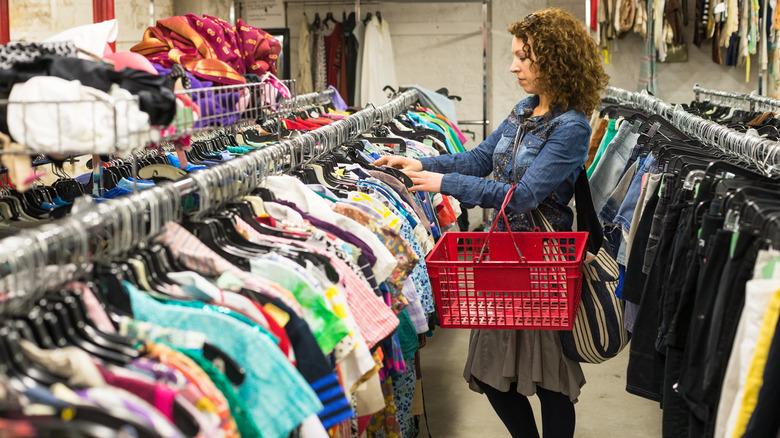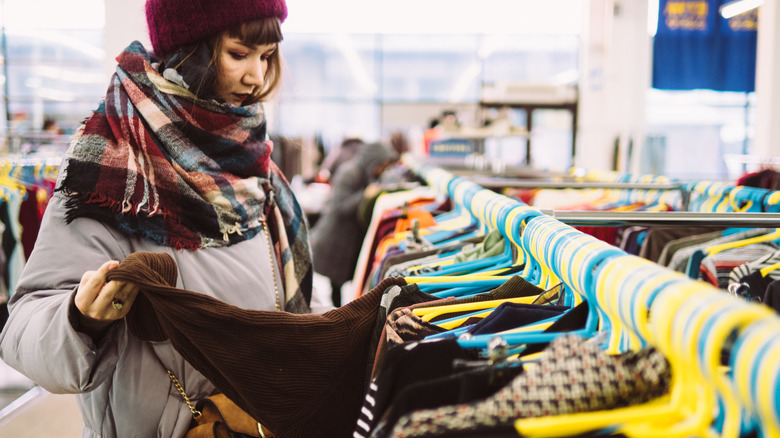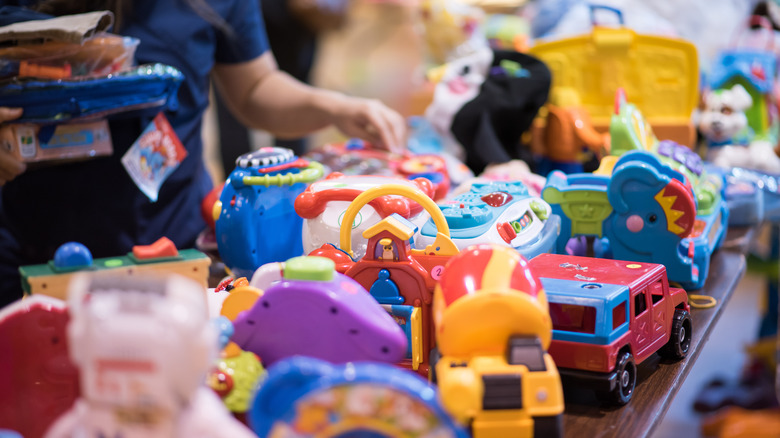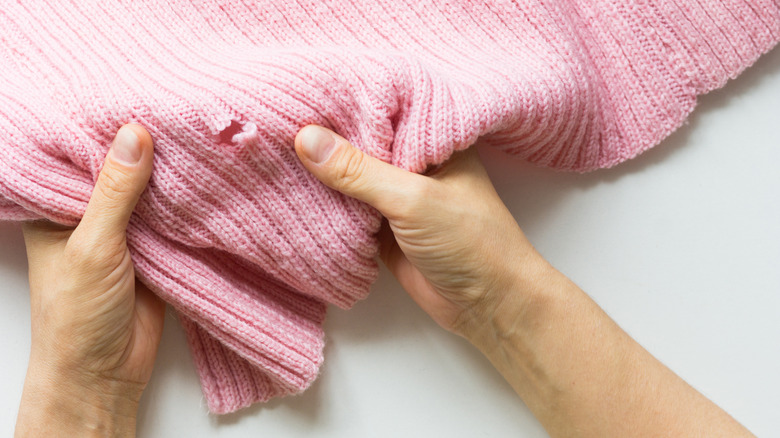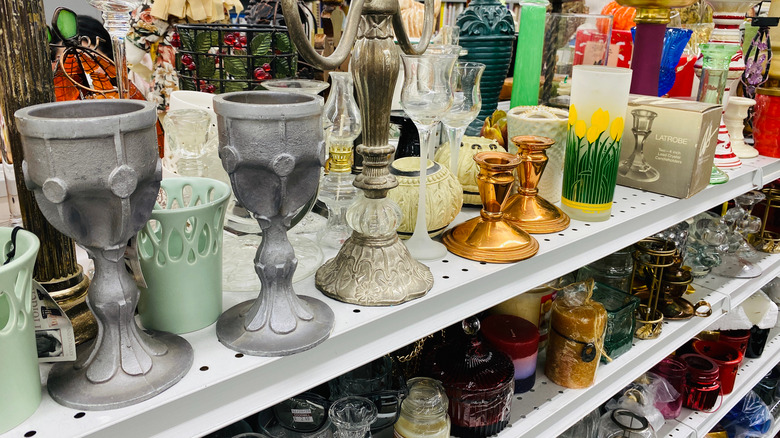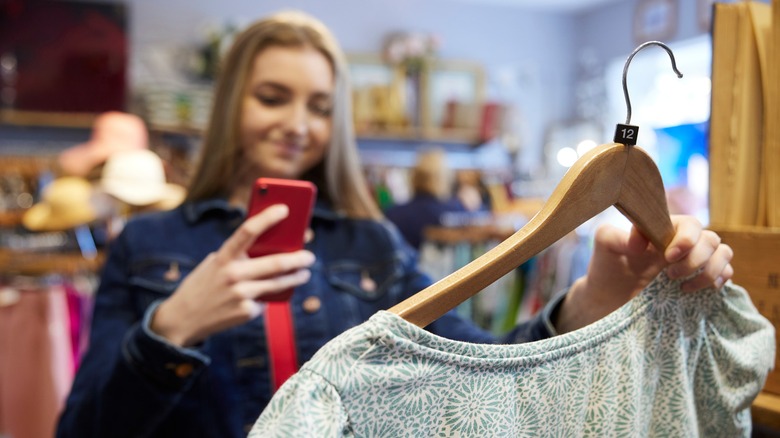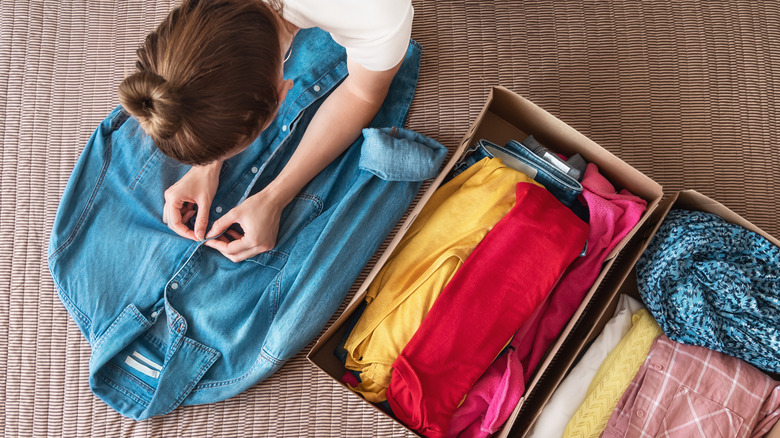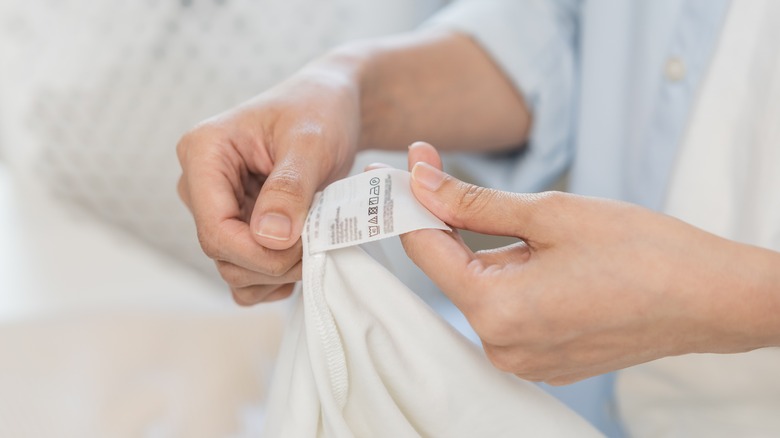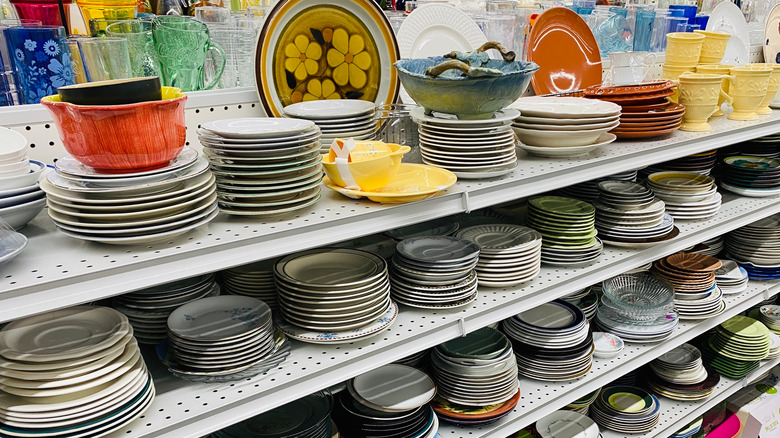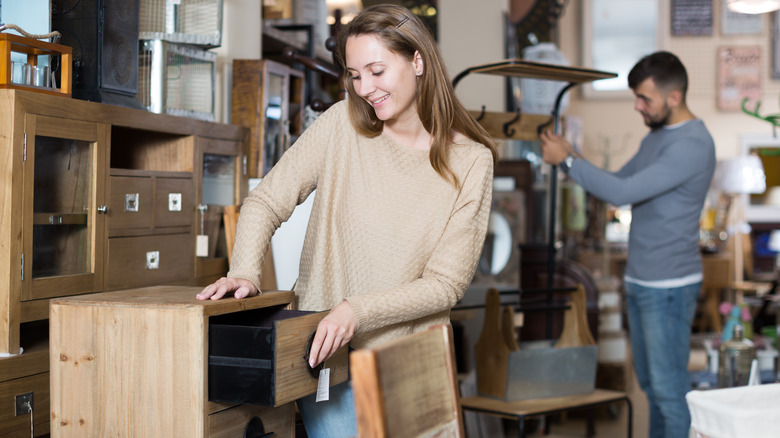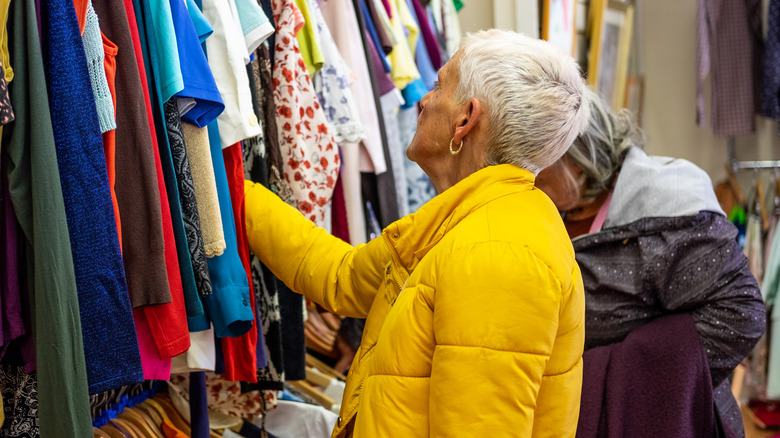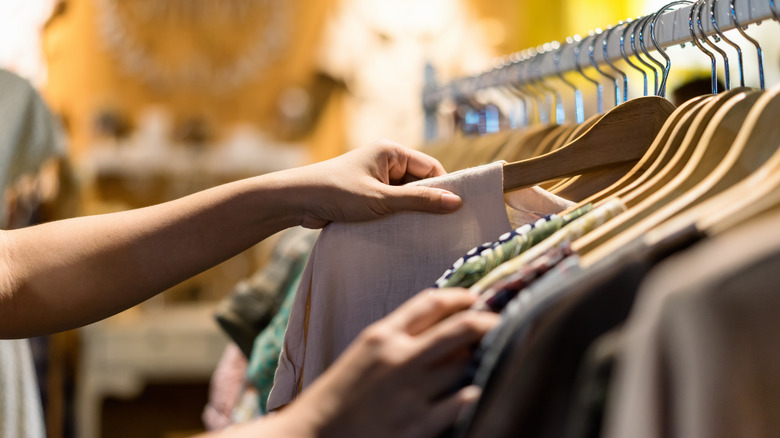What You Need To Know Before Your Next Thrift Store Trip
It may not be for everyone, but the thrifting experience — that is, thrift shopping at your local shops and/or stopping into thrift stores while traveling — can be the solution to many problems. The art of thrifting can help you save money, reduce your carbon footprint, and simultaneously support your local economy and community. In fact, as noted by Goodwill, thrifting is also sustainable and environmentally friendly because you're not contributing to the demand for new goods.
Although thrift stores and charity shops have been around for decades, even veteran shoppers encounter difficulty navigating them sometimes. After all, organization isn't exactly the strong suit of most secondhand shops, and it's easy to get overwhelmed by the sheer volume of merchandise and product inconsistency amid the racks and shelves. Anyone who's ever pawed through a particularly haphazard retail clearance rack at a big box store understands how similar the average thrift store experience is. But just like anything else in life, practice makes perfect when it comes to thrifting. So, what can you do to become a better thrift store shopper?
Bring a shopping list with you
Ever go to the store with the intention of grabbing a soda but end up leaving with a week's worth of groceries you didn't know you needed? Shopping at a thrift store without a plan is pretty much the same as going to the market on an empty stomach. Just because the secondhand store's concept is a little different doesn't mean you shouldn't be prepared before entering. Take it from those who have fallen into the thrift store trap: you can get too much of a good thing. "As a protective mechanism, I tried to do my shopping within the last 30 minutes of the store's hours to limit myself, but that didn't stop me from bringing home at least one bag of stuff a day," former thrift collector Lana St. Clair told the Daily Mail.
It's easy to want to pick up everything when prices on perfectly functional clothing and goods are lower than the dollar store (or $1.25 store). But this type of logic is precisely what leads to dangerous shopping habits. If you know you have the predisposition to spend as a result of boredom or other triggers, be conscious of the fact that things pile up, regardless of how little they cost you. In the long run, finding space to store excessive hauls from overshopping can drain your time, energy, and resources.
Steer clear of these potential dangers
An unfortunate problem in larger thrift shops is that recalled clothing or goods may inadvertently end up on the sales floor. For example, drawstrings in children's clothing were banned in 2003 by New York State. Although most retail establishments were able to circulate new inventory and adhere to the ban, thrift stores had difficulty thwarting the outlawed items from reappearing. Over a decade later, investigators still found the offending garments for sale across several New York thrift stores, according to CBS.
While it's illegal to sell any type of recalled goods in states like New York, the unfortunate truth is that items occasionally slip through the cracks due to the vast quantity of donations screened by thrift store employees. "Many consumers and thrift store operators may be unaware of recalls, bans and current safety standards of products offered for sale in the stores," former Consumer Product Safety Commission chairman Ann Brown stated in a CSPC release. Therefore, you should always exercise caution and examine secondhand children's clothing, furniture, and toys for potential hazards or recalls before purchasing.
Don't make the mistake of bringing home damaged goods
It's one of the most disappointing experiences a thrifter can have. Picture this: you excitedly make the perfect purchase, only to uncover moth holes, stains, or other aggravations upon getting it safely home. With natural fabrics like silk and wool, it's imperative to scan for signs of pests before checking out. "It's not the moth that's doing the damage; it's the worm. You know a hole is moth-related when there's also gritty fecal material and cocoon material," entomologist Jennifer Brumfield tells Consumer Reports. Finding flaws isn't always easy at first glance, but there are a few ways to reduce your chances of developing dreadful thrift-related regrets.
One helpful strategy is to whittle down your picks before you get to the register. Find a quiet, well-lit area of the store and thoroughly examine each item inside and out. Common issues with coats include loose buttons, shedding fur, and torn stitching in the interior lining. While minor things like buttons can be easily tightened, larger repairs, such as fur restoration, can cost more than the item's worth. In regards to dresses, jackets, and jeans, look for fraying hems, pilling, and broken zippers. If you have no problem mending these or other concerns, great, but if not, be careful not to take home a project.
Make sure you're bringing home the perfect fit
Another unfortunate plight of the frequent thrift store shopper? Falling in love with a one-of-a-kind item that just happens to fit terribly. Always try clothing on, even if you hastily throw something over your outfit to get a glimpse of its silhouette in the mirror. It's tricky to spot deal breakers like obnoxiously slouchy shoulders, too-short hems, and awkwardly-placed zippers without first taking pieces for a spin. One thrift store shopping trick that everyone should know is the waistband test. To try it, simply wrap the waistband of your desired pair of jeans or skirt around your neck to get a good idea of how they'll fit around your waist. Just remember that this shortcut doesn't take things like your inseam into account, so it may not work perfectly for every style.
And don't forget, the same goes for footwear — it can even be dangerous to wear shoes that show age or prior use, so make sure to look for pairs with minimal signs of wear. "[Shoes] can become stretched to the point where they no longer hold the foot in place when walking. This can cause the tendons and muscles to compensate, resulting in overuse injuries such as tendinitis," podiatrist Dr. Diane Koshimune tells Footwear News.
Thrifting can be a great way to source gifts
Buying things for yourself is always fun, but scoring great gifts for your nearest and dearest feels even better. Plus, if you're struggling to find the perfect present for the person who has everything, there's no better place to find inspiration than at your local thrift store.
Whether you're shopping for birthdays or the holidays, you'll uncover items that can't be purchased anywhere else at secondhand shops. "You can find more unique gifts and have spent more of your time choosing the perfect present – time is a gift money can't buy," shopping expert Monica Mills tells the Independent. Moreover, you can combine thrifted items with contemporary touches to elevate your gift-giving. Try pairing some antique candle holders with modern tapered candles or using an old ceramic pot as a chic planter, for example. Another fine way to repurpose pre-loved goods? Look for classic cut glass or crystal plates to produce stunning cookie or charcuterie platters for friends.
Item scarcity means that thrifting can be competitive
Every shopper can relate to this scenario: you pick up something eye-catching but start to waffle on whether or not you can live without it once it's in your cart. At most retail stores, there won't be any issue with setting something back on the shelf and coming back for it if feelings change. But thrifting is an entirely different story.
Some items may not last more than a few minutes on the floor before being scooped up by other customers, so think twice before relinquishing them. You don't have to commit to purchasing everything in your trolley, but be judicious about which pieces you can't live without to avoid heartache. But don't worry if you do happen to lose sight of something precious during your thrifting ventures — there will always be other treasures to uncover. "I don't think we'll ever be in a place where we don't have stuff. Part of our culture in America is that we are consumers and we are replacers," Greg Tuck, assistant national community relations and development secretary at The Salvation Army USA, told The Wall Street Journal.
Try this rule to keep your thrifting habits balanced
Catching sales is one of the joys of thrifting — when prices are already low, it's hard not to want to stock up during clearance events at stores. "I do my best to remind my community that the most sustainable option is what is already in their closet. Don't replace a fast-fashion shopping addiction with a thrifting addiction," sustainability influencer Judy Limón tells Insider. In order to prevent overaccumulation, there's one easy strategy you can use to maintain a sense of balance.
As you clean out your wardrobe, keep a bag of donations near your closet and add to it throughout the month. Then, store these items in the trunk of your car, so they're ready to drop off when you head out for your next shopping trip. By doing this routinely, you can minimize excess clutter by off-setting future purchases while giving fellow thrift shoppers some new finds to enjoy. It's a win-win for everyone involved.
Consider the composition of clothing before buying
No matter what kind of look you're going for, comfort should be a top priority when sourcing thrifted clothing. Fabrics like nylon and polyester are perfect for athletic wear, but may not be the best choice when it comes to everyday garments. "Synthetic fabrics tend not to breathe as well, release microplastics into our water system, and they don't hold their shape well or last long," fashion blogger Saraid Claxton tells Consumer Reports. Many contemporary pieces on thrift store floors are made from synthetic textiles, but you can still find clothes made from blended materials or natural fabrics if you look hard enough.
Another factor to consider is the amount of life left in your secondhand finds. In order for outfits to be truly sustainable, they should be able to stand the test of time. Look for clues that indicate higher quality construction, like hand-stitching, and check labels for information about the materials used and care instructions.
Stay informed about vintage cookware and kitchen tools
Unfortunately, vintage cookware and kitchen tools were once fashioned using hazardous materials, from lead paint exteriors to BPA-filled plastics. At the time of their production, the effects of these substances weren't as well-known. But because many of these products enter thrift stores without detailed label information, it's best to exercise caution when purchasing older cookware, appliances, and food storage items. "Lead is typically found in highly pigmented paints and lacquers or sealants used in ceramic dishware. A piece of dishware or pottery with lead paint can be impossible to distinguish from one with non-leaded paint," Diane Calello, medical director of the New Jersey Poison Control Center, tells Consumer Reports.
Even if an older item seems to be in good condition, it still may not be safe or healthy to use. For example, a single scratch in a nonstick pan can release millions of microplastics into food while cooking, according to a recent study published in Science of The Total Environment. "We must be careful about selecting and using cooking utensils to avoid food contamination," study researcher Youhong Tang tells Flinders University.
Thrifting isn't just about find clothing
Most thrifts have more to offer than just clothing and accessories. If you're looking for home furnishings, there's plenty to be found at thrift stores and similar secondhand shops. Of course, saving money is one of the biggest motivators in buying pre-loved items, but there are other benefits to purchasing used home goods. "Older furniture is usually built to last, while newer big box furnishings can break in a few years and end up in a landfill, contributing to greenhouse emissions," interior designer Rebecca Hay tells Apartment Therapy.
Don't be deterred by minor flaws such as dings or water marks, as you can easily refinish scuffed wood. Larger problems may require professional repairs, but if you know you have a special piece, it could be worth it. Still, be careful when purchasing older lamps or electronics. Over time, the vintage wiring inside of them can decay, posing safety risks.
Be considerate toward your fellow thrifters
It's no secret: online resellers and brick-and-mortar vintage dealers love thrifting, and it's a very profitable game for them. But back when those quirky vintage pieces were initially produced, early thrift stores essentially had one mission: to supply consumers with goods that they couldn't afford to purchase otherwise. It's a harsh reality that gets overlooked these days, but not everyone is thrifting for the fun of it. Buying secondhand is often necessary for those who live with budgeting limitations or fixed incomes.
Stay mindful of the fact that many shoppers have few (if any) other options to find adequate clothing, outerwear, and other merchandise at affordable prices. Many thrift stores are raising prices across the board, disproportionately affecting low-income shoppers because of the effects of flippers. Despite the argument that there will always be more inventory, researchers agree: resellers have created a looming problem for shoppers who thrift out of necessity. "[Today] there are less quality items left on thrift store shelves for those who truly have no other affordable options, say, for buying professional attire that could mean the difference between impressing or crashing at a job interview," a Berkeley Economic Review study states.
Make sure you sanitize clothing, textiles, and linens
Oftentimes, thrifted clothing arrives at stores in one massive bundle, similar to a rubberband ball. Employees sort these donations before they hit the sales floor, but there's no foolproof way to discern freshly laundered pieces from those with a bit of funk once they've mingled in donation bins. Still, just because an item appears to be clean doesn't mean that it's sanitary to wear straight off the shelf. In a recent study by the Iranian Journal of Public Health, nearly 3% of secondhand clothing tested by researchers was found to contain transmissible parasites like lice and scabies.
The reality is that thrift store clothes aren't inherently dirty, but it's always better to be safe than sorry. To avoid bringing home unwanted guests, ensure you sanitize clothing, linens, and other fabrics before adding them to your wardrobe. Laundry add-ins, like borax powder and sanitizing agents, are helpful in reducing the spread of parasites and bacteria. To clean thrifted clothes, you can wash most items in a high-heat setting to ward off potential pathogens. However, always exercise caution with delicate garments or those with natural fibers like wool and silk — these items may require hand-washing or dry cleaning to prevent any damage.
If you're serious about finding deals, visit frequently
Unlike standard retailers, thrift stores have no idea what to expect from each shipment that arrives at their doors. Every secondhand shop is different, but their inventory is typically generated from donations and, sometimes, generous contributions from name-brand stores with discontinued or overstock merchandise. Some say that the best time to thrift shop is within the first hour of a store's opening, so that you can check out the new wares from the previous evening. Still, it's hard to say what will arrive from day to day, and the truth is that you'll want to visit regularly to get a glimpse of the best finds.
Just like striking gold at a firsthand retailer's clearance rack, finding truly special items at thrift stores is more or less the luck of the draw. "Remind yourself that the feeling of FOMO is short-lived," psychologist Dr. Mindy Weinstein tells GOBankingRates. Our best advice on thrift store FOMO? Don't drive yourself up a wall trying to be omnipresent at your local shops, but visit somewhat often if you have a particular item you're looking for. What's meant to be will be, and it's worth noting that, in many cases, certain sought-after items have a way of finding their way to the right owner.
